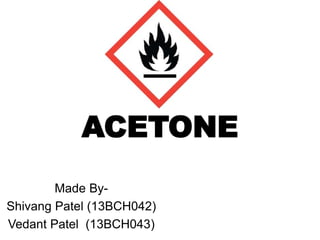
Acetone
- 1. ACETONE Made By- Shivang Patel (13BCH042) Vedant Patel (13BCH043)
- 2. OVERVIEW • Introduction • About the compound. • Structure. • Properties. • History. • MSDS. • Preparation. • Major Producers. • Production and Consumption. • Statistics.
- 3. ABOUT THE COMPOUND • Acetone (IUPAC name Propan-2-one) is the organic compound with the formula (CH3)2CO. It is the Simplest Ketone. • Acetone serves as an important solvent in the lab as well as in the industry. • It also serves as a cleaning agent as it is able to dissolve almost all the compounds.
- 4. STRUCTURE
- 5. PROPERTIES Molecular formula : C3H6O Molar mass : 58.08 g·mol−1 Appearance : Colorless liquid Odor : Pungent, Irritating, Floral Density : 0.791 g cm−3 Melting point : −95 °C; −139 °F; 178 K Boiling point : 56 °C; 133 °F; 329 K Solubility in water : Miscible Solubility miscible in : Benzene, diethyl ether, methanol, chloroform, ethanol Vapor pressure : 9.39 kPa (0 °C) 30.6 kPa (25 °C) 374 kPa (100 °C) 2.8 MPa (200 °C) Acidity (pKa) : 19.2 Refractive index (nD) : 1.359 Viscosity : 0.36 (10 °C) 0.295 cP (25 °C)
- 6. HISTORY • Industrial exploitation of ABE (Acetone–butanol- ethanol) fermentation started in 1916, during World War I, with Chaim Weizmann's isolation of Clostridium acetobutylicum. • Thus the first lab production of acetone dates back to 1916. • Also Acetone was the reason that the Germans lost the World War 1.
- 7. MSDS
- 8. MSDS
- 9. PREPARATION • Acetone is produced using different methods:- 1. Cumene Process. 2. From Alkane nitriles. 3. Hydrolysis of Gem-Dihalides. 4. Oxidation of isopropyl alcohol. 5. Ozonolysis of alkenes. 6. Fermentation process.
- 10. 1) CUMENE PROCESS • The air oxidation of cumene (isopropyl benzene) leads to the production of both phenol and acetone, as shown in the following figure. The mechanisms for the formation and degradation of cumene hydroperoxide require closer looks, which are provided following the figure.
- 11. REACTIONS
- 12. REACTIONS
- 13. REACTIONS • At the end of reaction we get Acetone as well as Phenol both of which are desirable.
- 14. MECHANISM • In the Initiation step the intermidiate Tertiary Benzylic Radical is formed.
- 15. MECHANISM • Here Cumene Hydrogen Peroxide is formed and the unreacted Cumene helps in further production of free radical.
- 16. MECHANISM
- 17. 2) FROM ALKANENITRILES • Reaction of Grignard reagent with alkane nitriles followed by hydrolysis results in formation of ketones.
- 18. REACTIONS • So, Ethanenitrile reacts with Methylmagnesium bromide and it is followed by hydrolysis. • At the end of hydrolysis we get acetone.
- 19. MECHANISM • Step 1: Nitriles reacts with grignard reagent and to produce magnesium salt of imine.
- 20. MECHANISM • Step 2: Then imine followed by hydrolysis and to produce ketone.
- 21. 3)HYDROLYSIS OF GEM- DIHALIDES • Ketones are produced by alkaline hydrolysis of those gem-dihalides in which the two halogen atoms are attached to a non-terminal carbon atom.
- 22. REACTIONS • So, 2,2-Dichloropropane followed by alkaline hydrolysis and at last acetone will produce.
- 23. MECHANISM • Step 1: Alkaline hydrolysis with gem-dihalide and it produces mono helo hydroxy compound. • Step 2: Again nucleophilic substitution to form di hydroxy compound. • Step 3: It wll eleminate water molecule and to form ketone.
- 25. 4) OXIDATION OF ISOPROPYL ALCOHOL • Ketones can be prepared by controlled oxidation of secondary alcohol using an acidified solution of potassium dichromate.
- 26. REACTIONS • So, 2-Propanol followed by oxidation process and produce acetone.
- 27. 5) OZONOLYSIS OF ALKENES • Ozone is passed through an alkene in an inert solvent, and it form an ozonide. • Ozonide are explosives compounds. • Then warming with zinc and water , it will form aldehydes, ketones or an aldehyde and ketone, depending upon structure of alkene.
- 28. REACTIONS • So, 2-Methyl-2-butene followed by ozonolysis reaction and produce acetone and acetaldehyde.
- 29. MECHANISM
- 30. 6)FERMENTATION PROCESS • The process may be likened to how yeast ferments sugars to produce ethanol for wine, beer, or fuel, but the organisms that carry out the ABE fermentation are strictly anaerobic(obligate anaerobes). The ABE fermentation produces solvents in a ratio of 3 parts acetone, 6 parts butanol to 1 part ethanol. It usually uses a strain of bacteria from theClassClostridia (Family Clostridiaceae). Clostridium acetobutylicum is the most well-studied and widely used species, although Clostridium beijerinckii has also been used with good results.
- 31. MAJOR PRODUCERS • Indian producers and their installed capacity: Source: Govt. of India, Ministry of Commerce, Antidumping statement dated 10th April 2012
- 32. ANNUAL ALL INDIA PRODUCTION LEVEL OF ACETONE Source: Annual Report , Ministry of Chemicals & Fertilizers, Department of Chemicals and Petrochemicals
- 33. COUNTRY WISE EXPORTS Source: Annual Report , Ministry of Chemicals & Fertilizers, Department of Chemicals and Petrochemicals
- 35. IMPORTS OF INDIA Source: Annual Report , Ministry of Chemicals & Fertilizers, Department of Chemicals and Petrochemicals
- 36. DEMAND AND SUPPLY GAP Source: Annual Report , Ministry of Chemicals & Fertilizers, Department of Chemicals and Petrochemicals
- 37. Thank You